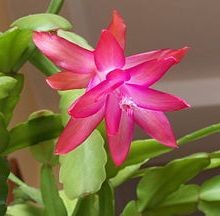Schlumbergera microsphaerica
(Schlumbergera microsphaerica)

Description
Schlumbergera microsphaerica is a species of plant in the family Cactaceae. It is endemic to a limited area of the coastal mountains of south-eastern Brazil where its natural habitat is rocky areas above 2,600 m (8,500 ft). It is threatened by habitat loss. It is in the same genus as the popular house plant known as Christmas cactus or Thanksgiving cactus. Schlumbergera microsphaerica resembles other species of the genus Schlumbergera in that it has leafless green stems, made up of distinct segments, which act as photosynthetic organs. However, most other species have strongly flattened stems, whereas S. microsphaerica has branching stems made up of narrow, more or less cylinder-shaped segments, each 1.5–4.0 cm (0.6–1.6 in) long by 2–5 mm (0.1–0.2 in) in diameter. Special structures characteristic of cacti, called "areoles", occur in a roughly spiral fashion over the stems. The areoles, which may have bristles, are where the flower buds appear. The flowers usually hang down and are more or less regular (radially symmetrical or actinomorphic). They are described as "fuchsia red" to white in colour and are about 1.5 cm (0.6 in) long. In cultivation in the Northern Hemisphere, plants flower in the spring – March to April. The fruit is green, with up to five not very prominent ribs. The brown seeds have a diameter of about 1 mm (0.04 in). The epithet microsphaerica is derived from the Greek mikros meaning small and sphairikos meaning spherical. The stem segments of the species are shaped like small cylinders or spheres. Like the taxonomy of the genus (see Schlumbergera: Taxonomy), the taxonomy of Schlumbergera microsphaerica is complicated. The first person to name the species was Schumann in an 1890 paper in which he described three species: Cereus microsphaericus, C. obtusangulus and C. parvulus. However, he seems to have decided afterwards that the three species were not distinct, and in a monograph published later, which included an illustration, used only the name C. obtusangulus, although he did not actually say that the three species were the same. On this basis, some authors used C. obtusangulus as the basionym ("base name") when they later transferred the species to Epiphyllanthus (Berger in 1905), Zygocactus (Löfgren in 1918), Epiphyllum (Lindberg in 1926) and Schlumbergera (David Hunt in 1969).
Taxonomic tree:







